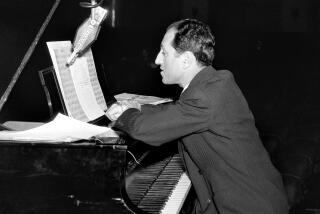Gershwins Were No Fans of Preminger’s ‘Porgy’
- Share via
Trevor Nunn’s interpretation of the work has found favor with Gershwin’s heirs. “He’s given the characters an emotional base in a way no one has done before,” said Michael Strunsky, nephew of Leonore Gershwin and sole trustee and executor of Ira Gershwin’s estate, which has managed “Porgy and Bess” for the last 40 years.
Speaking by phone from his San Francisco office, Strunsky said Nunn had “given a sense of nobility to Porgy, his integrity and belief in the future. Taking Porgy off his knees and putting him on crutches has given him a more realistic flavor. Before, it was hard for audiences to empathize with his problems.”
Strunsky confirmed that this was only the second occasion that film rights for “Porgy and Bess” had been granted. Ira and Leonore Gershwin, he said, were unhappy with Otto Preminger’s 1959 film of the work, which starred Sidney Poitier, Dorothy Dandridge, Pearl Bailey and Sammy Davis Jr. The film was the last to be produced by Samuel Goldwyn.
“That film was unfortunate, but typical of (social) attitudes of the time,” Strunsky said. “My aunt didn’t want it distributed. She and my uncle felt it was a Hollywoodization of the piece. We (the estate) now acquire any prints we find and destroy them. We are often approached for permission to show the film, which we consistently deny.
“You just have to look at the set of Trevor’s production, then at the Goldwyn film. The old one looked like the Place de la Concorde--large, opulent, paved with cobblestones. It gave no flavor of Charleston at the time at all.”
He added that two other attempts to film “Porgy” had been made by major producers, but permission had been denied.
“The impetus for this film began when my aunt went to see Trevor’s production at Glyndebourne. She felt this was what ‘Porgy and Bess’ should be, emotionally, musically and intellectually.”
More to Read
Only good movies
Get the Indie Focus newsletter, Mark Olsen's weekly guide to the world of cinema.
You may occasionally receive promotional content from the Los Angeles Times.







